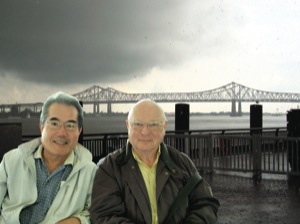
Being invisible is not easy, but it is a situation LGBT seniors face daily. We are not ignored, that is deliberate; we are just not there. It saddens and, at times, infuriates seniors to be denied the chance to communicate our knowledge and experiences to the younger crowd; to compare our lives and enrich each other.
Seniors love to talk about the “old days,” so by opening up to friendly conversations, the new generations would hear fascinating first-hand stories of another time and place. Many stories are funny and delightful, but some are not.
For example, we seniors did not have gay marriage. We had long term relationships that somehow survived until the present. Let’s look at some friends in our community celebrating relationships begun in the ‘70s and ‘80s when the gay/lesbian world was one of secrets, hiding and shame; a time when we lived under the threat of being jailed, fired and disowned; making it worse came whispers about something called AIDS.
With all that going on, how did gays and lesbians get together, live together and, more importantly, stay together?
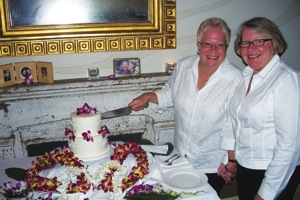
Contributing to this article are eight couples celebrating 30-42 years together. Their thoughts and memories will open up a world of prejudice that is nearly unthinkable to young people today.
The first and main point of agreement by all was that in the ‘80s same-sex couples living together in small town America meant harassment or worse. For a stable relationship, moving to a safe location was vital. “We had to get out of Dodge,” as Debra Altschuler and Judy Neidert put it.
Popular choices were New York’s Greenwich Village or the Castro and Berkeley areas of San Francisco where they found acceptance, support and, in several cases, each other.
Vietnam vets Bill Kelly and Bob Taylor remember that in Chicago they experienced considerable discrimination and isolation from their heterosexual counterparts, and took refuge in Chicago’s “Gay Ghetto” where, “… we had an LGBT community to rely upon, while being forced to lead double lives as heterosexual employees by day and as men who happened to be gay with life mates and in the privacy of our homes by night.”
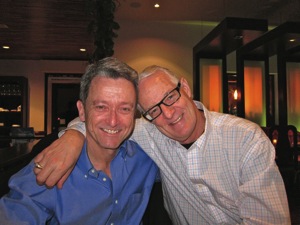
In my own case, my partner Yohei Yamamoto and I lived in Tokyo separately, because there gays and lesbians lived in the closet. As for myself, with many foreign gay and lesbian teachers in Tokyo, I had a gay social life which he shared. However, it was essential to be discreet; any public gay connection to the university where I taught would have resulted in instant dismissal.
Closer to home, John La Rocque and Ed Moores, fearful their jobs would be terminated by homophobic supervisors, also lived in separate houses in nearby Vista until they retired just ten years ago.
To enjoy a gay life back then, it was necessary to stay strictly in the correct areas. For example, the clear acceptance which Debra and Judy had in Greenwich Village was missing when they moved to a nearby affluent suburb. Their relationship was undoubtedly known, but unspoken vibes led to keeping their lives private, like Bill and Bob in Chicago, especially at work.
On the happier side of the coin, two couples were very fortunate to have met, live and work in the Berkley area of San Francisco. John Berecochea worked in an AIDS related organization and Jerry Ondercin taught there, so there was little or no negative feedback. Especially lucky were “Frank and Paul,” the bi-racial couple whose pleasant life in Berkeley was a far cry from other areas of the country where it would have been dangerous just walking down the street together and living as a couple would have been out of the question.
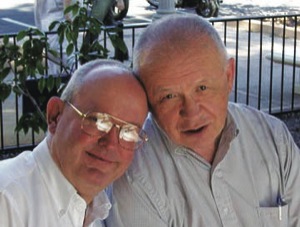
Surrounded by AIDS and homophobia, couples such as ourselves hung on to each other; our togetherness provided a sanctuary to the extent of somehow managing a social life while still more or less in the closet; getting together quietly at home with our small pool of friends who lived in the same style. When possible, there was always a weekend trip to New York, San Diego or out of the country. A social life with straight people took place only when unavoidable and then never with our partner.
Malcolm and Joe in New York City and Jerry and John in San Francisco were luckier and enjoyed an expanded social life with non-gays/lesbians. Not everyone partied; Debra and Judy, for example, said they, like several of their lesbian friends, “nested,” that is, they were content to stay cozily at home and seldom ventured out for socializing.
Staying within a closed circle of friends was vital, because for the first 10-15 years none of us dared take part in the few, if any, gay social clubs or public/political events. Debra and Judy were exceptions who, a few years into their relationship, got up the courage to attend a Pride parade; daring to actually march, however, was still too dangerous for their job security. Soon thereafter, they did join their sisters in the wonderful lesbian AIDS support activities when the plague was taking so many of our friends and partners. Later, as gay acceptance increased, some of these couples became braver and Bill and Bob especially are now strongly involved in gay politics and charities.
No matter where we lived, stress, secrecy and fear brought unnecessary tension into our lives, together with the normal problems two people living together have to overcome, including in-law approval. At first, there were some unhappy relatives of some in our study, to be sure, but by not angrily demanding acceptance and keeping calm, eventually most adapted to the times with attitudes ranging from being polite to fully accepting.
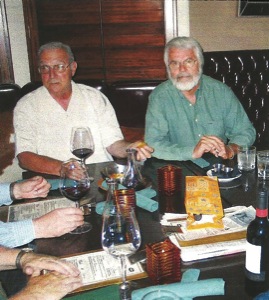
As years passed, the New York, Chicago and Vista couples got fed up with the prejudice at work and the stress of living where they were not welcomed. To preserve their relationships, they decided to gamble everything by leaving their prestigious, well-paying jobs and businesses and heading to supposedly gay-friendly San Diego. With no bosses to worry about and no glass ceilings to hit, they started their own businesses. The move was so critical that in many respects their relationships can be divided into before and after coming here.
Recently undreamed of options appeared: domestic partnerships and marriage. Jerry and John availed themselves of the chance to marry as soon as it appeared five years ago. Debra and Judy did the same and were especially moved by their marriage ceremony. They said they felt equal as human beings for the first time in their lives.
Summing up, staying together during the early years was made possible by living where we were welcome (at least not unwelcome), keeping a low profile and when a wrinkle appeared, consciously not avoiding the issue, but together working to smooth out the problem. True, that was 20-30 years ago and things have definitely changed. What has remained constant in maintaining a relationship is the need to compromise, talk it out, hang in there and, of course, let each other know the love is still there. It is worth the struggle.












I have been in a relationship for 34 years and this article misrepresents,
” staying together during the early years was made possible by living where we were welcome (at least not unwelcome), well not true for many….while I applaud all relationships including those who contributed to this article. We have spent the majority of my life living rural. Our stories differ.
” It saddens and, at times, infuriates seniors to be denied the chance to communicate our knowledge and experiences to the younger crowd; to compare our lives and enrich each other.” It has never been easier to communicate with younger generations via social media…I know several seniors don’t likethe way the young look,speak or communicate.
“Seniors love to talk about the “old days,” YES THEY DO, could learn of the here and now by talking less and listening more.Better conversation, but it would require listening and I find many are inclined to judge and dismissive even hostile towards younger generations much less listen to them because many feel superior…it is not the fault of a proud young generation that they did not lose a generation of friends, yet…many of us older ones are still bitter and carry that with us,…so hopefully we will both find a way to communicate without boring the bajezbus out of one another.
Lastly if you think all has changed, unlike twenty or thirty years ago I would urge you to consider, it is much worse in much of rural America and the backlash we are experiencing is so that many couples have the right to marry in their zip code…nothing has changed ‘back here’ more legal hate… listening ears!
I can relate to it all….as a senior
I do have one complaint: the LGBT center in NY has segregated the seniors from the youth by opening up two floors in a business building 14 blocks away. Who wants to be only with seniors. It’s like being in a senior community.
Shame on them that could not make room for us and chose us seniors to
move out.
very lucky for San Diego couples sorry my comments were sour grapes and frustration.